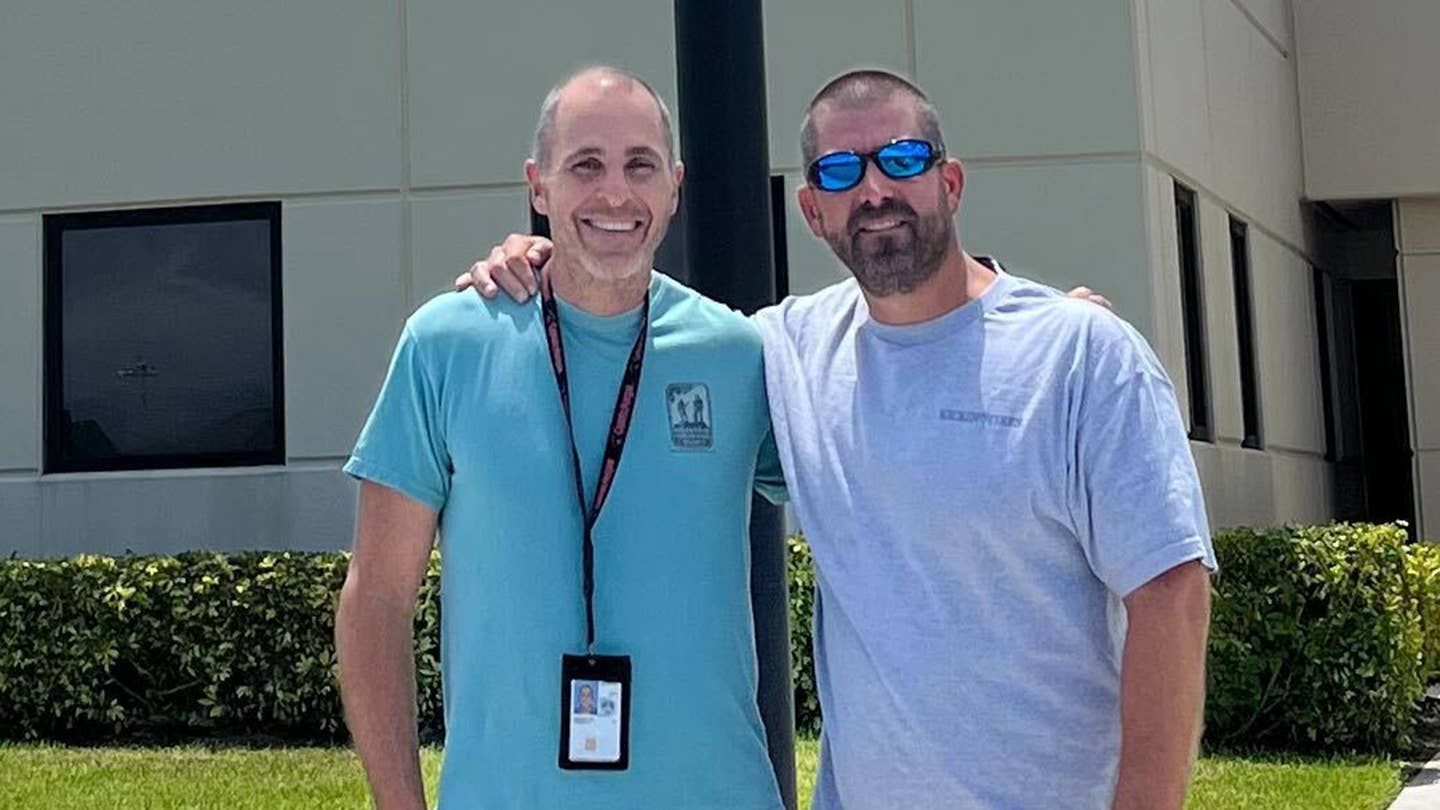How Two Air Traffic Controllers Helped a Passenger Land an Airplane
One controller’s experience as a pilot and instructor came into play.

Controller Robert Morgan, left, with the passenger he helped land a single-engine Cessna safely after an unusual in-flight emergency. [Courtesy: FAA]
What seemed like a routine charter flight from the Bahamas to Florida on Tuesday took an unexpected turn for two passengers in a Cessna 208 Caravan when the pilot became incapacitated, slumped against the controls, and sent the aircraft into a dive.
The day also changed for air traffic controllers Chip Flores and Robert Morgan.
Flores was handling air traffic in the Fort Pierce Tower at Treasure Coast International Airport (KFPR). A trainee controller and a trainer were directing ground traffic, and a supervisor was overseeing the operation.
“I just glanced over at my supervisor, put the call on speaker so everyone could hear, and then we got to work.”
Chip Flores, controller, Treasure Coast International Airport (KFPR)
“It had been kind of a slow hour for that shift,” Flores told FLYING, explaining that windy conditions had kept traffic to a minimum. Then a call came in from a passenger who said he was in a “serious situation” after his pilot suffered an apparent medical problem that left him incapacitated.
“I just glanced over at my supervisor, put the call on speaker so everyone could hear, and then we got to work,” said Flores, who has taken flight training but is not a pilot.
Flores coached the passenger—Darren Harrison, who works in interior design for Sunshine Interiors in Lakeland, Florida—on keeping his wings level and switching to the approach frequency at Palm Beach International Airport (KPBI). But the passenger—who the FAA says had no prior piloting experience—could not operate the radio. So Flores, who was beginning to lose radio contact with the passenger, handed him off to Morgan, who was on duty at Palm Beach. Morgan used a portable emergency radio to tune the Fort Pierce frequency the passenger was already using.
Morgan, who is a commercial pilot and certified flight instructor, told FLYING his piloting experience shaped the way he handled the emergency. “I wanted to keep everything as simple as I could for the passenger, who had no flight training,” he said. “I wanted him to fly straight, wings level, and make as few turns as possible. I tried to make it easy.”
When Morgan and the passenger at the controls began talking, the Caravan was closest to Boca Raton Airport (KBCT), Morgan said, “But I didn’t have a good feeling about that and decided to take him to Palm Beach because of the 10,000-foot runway. Boca’s runway is more than 6,000 feet, but I wanted him to have as much runway as possible. I wanted to be confident that as long as he could get onto the runway, he would be OK.”
Morgan guided the passenger through a long, shallow turn to an eight-mile final approach starting at around 2,000 feet. At that point, he had the passenger set the flaps to 10 degrees, mainly to slow the airplane down, but the passenger began to have trouble controlling the airplane after the flaps deployed.
“I gave the pilot constant altitude callouts: ‘You’re at four miles, 1,200 feet, you’re at two miles, 600 feet.’ He was aviating, I was helping."
Robert Morgan, controller, Palm Beach International Airport (KPBI)
“I had him retract the flaps. By that time, he was holding 130 knots on the final and I figured that would work. Morgan, who has not flown Caravans before, used printouts made on the spot by colleagues to help him describe to the passenger which controls he wanted him to operate, such as the throttle, trim wheel, and brakes. He also made a point of speaking to him during the entire approach.
“I gave the pilot constant altitude callouts: ‘You’re at four miles, 1,200 feet, you’re at two miles, 600 feet.’ He was aviating, I was helping. I felt my flight instructor stuff was really coming into play. I lined him up with the runway, told him how the runway would look and gave him a good target to aim at.”
At about 300 feet, the airplane disappeared from the radar screens in the room in which Morgan was working. This is normal at such a low altitude, he said, but for a few seconds, he did not know whether the landing had gone well.
“Then I heard the pilot say, ‘I’m on the ground now. How do I stop it?’ I had him apply the brakes. I had pointed out their location earlier. Then he asked if he should turn off the runway, but the emergency crews were there, so I told him he didn’t have to worry about that.”

Sign-up for newsletters & special offers!
Get the latest FLYING stories & special offers delivered directly to your inbox






